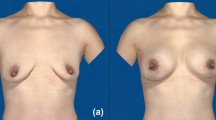Abstract
Background
In addition to the already existing round cohesive gel-filled breast prostheses, anatomically shaped breast prostheses were introduced in 1990 to provide a more natural shape to the augmented or reconstructed breast. To date, however, it is unclear whether the anatomic configuration of the prostheses is maintained after subpectoral implantation. Recently, a three-dimensional (3D) magnetic resonance imaging (MRI) technique became available, offering a precise visualization of the prosthesis in vivo. Using this 3D MRI technique, this study aimed to compare the shape of commercially available round and anatomically shaped silicone gel-filled breast prostheses before and after implantation.
Methods
Using 3D MRI, 6 conventionally round and 12 symmetrically shaped silicone gel-filled prostheses were scanned in vitro. Scans were made in vivo 6 weeks after subpectoral implantation of these prostheses in nine patients. The in vivo 3D images were compared with the in vitro 3D images.
Results
Overall, a 3.5% decrease in projection was found on the in vivo images, as compared with the in vitro images. On the craniocaudally oriented images, a slight lateral shift of the cohesive gel was observed in the majority of the prostheses. Inamed Style 510 prostheses showed the best in vivo preservation of their configuration.
Conclusions
The results show that both the round and the anatomically shaped silicone prostheses in vivo largely maintain their original in vitro configuration after subpectoral implantation.



Similar content being viewed by others
References
Baker JL (1979) Augmentation mammaplasty. In: WC Grabb (ed) Plastic surgery. 3rd ed. Little Brown: Boston, pp. 179–182
Beekman WH, Hage JJ, Taets van Amerongen AH, et al. (1999) Accuracy of ultrasonography and magnetic resonance imaging in detecting failure of breast implants filled with silicone gel. Scand J Plas Reconstr Hand Surg 33:415–418
Beekman WH, Scot MG, Taets van Amerongen AH, et al. (1996) Silicone breast implant bleed and rupture: Clinical diagnosis and predictive value of mammography and ultrasound. Ann Plast Surg 36:345–347
Cronin TD, Gerow FJ (1964) Augmentation mammaplasty: A new “natural feel” prosthesis. ransactions of the Third International Congress of Plastic and Reconstructive Surgery, Amsterdam. Excerpta Medical 41–49
De Becker J, Rozijn T, Visser F, Jones A, Beekman WH (2005) Siliconeonly breast MRI using an inversion recovery TSE sequence with a B1 independentspectral selective water suppression prepulse (SPAIR). Proceedings Intl Soc Mag Reson Med 13:1858
Fagrell D, Berggren A, Tarpila E (2001) Capsular contracture around saline-filled, fine-textured, and smooth mammary implants: A prospective 7.5-year follow-up. Plast Reconstr Surg 108:2108–2112
Fruhstorfer BH, Hodgson EL, Malata CM (2004) Early experience with an anatomical soft cohesive silicone gel prosthesis in cosmetic and reconstructive breast implant surgery. Ann Plast Surg 53:536–542
Hamas RS (2000) The comparative dimensions of round and anatomical saline-filled breast implants. Aesth Surg J 20:281–290
Hamas RS (1994) The postoperative shape of round and teardrop saline-filled breast implants. Aesth Surg J 19:369–374
Heden P, Jembeck J, Hober M (2001) Breast augmentation with anatomical cohesive gel implants: The world’s largest current experience. Clin Plast Surg 28:531–552
Hidalgo DA (2000) Breast augmentation: Choosing the optimal incision, implant, and pocket plane. Plast Reconstr Surg 105:2202–2216
Hobar PC, Gutowski K (2001) Experience with anatomic breast implants. Clin Plast Surg 28:553–558
Maillard GF (1995) McGhan style 410 anatomic breast implant. Plast Reconstr Surg 96:495–496
Spear SL, Mardini S (2001) Alternative filler materials and new implant designs: What’s available and what’s on the horizon? Clin Plast Surg 28:435–443
Tebbets JB (1998) Use of anatomic breast implants: Ten essentials. Aesth Surg J 18:377–384
Tebbets JB (1996) What is adequate fill? Implications in breast implant surgery. Plast Reconstr Surg 97:1451–1454
Author information
Authors and Affiliations
Corresponding author
Electronic Supplementary Material
Supplementary material
Rights and permissions
About this article
Cite this article
Nipshagen, M.D., Beekman, W.H., Esmé, D.L. et al. Anatomically Shaped Breast Prosthesis in Vivo: A Change of Dimension?. Aesth Plast Surg 31, 540–543 (2007). https://doi.org/10.1007/s00266-007-0025-3
Received:
Accepted:
Published:
Issue Date:
DOI: https://doi.org/10.1007/s00266-007-0025-3




